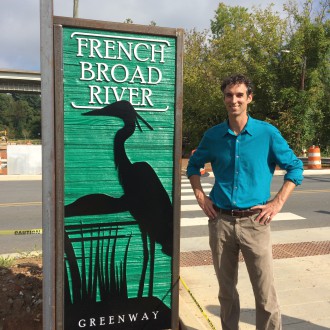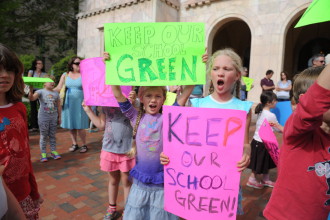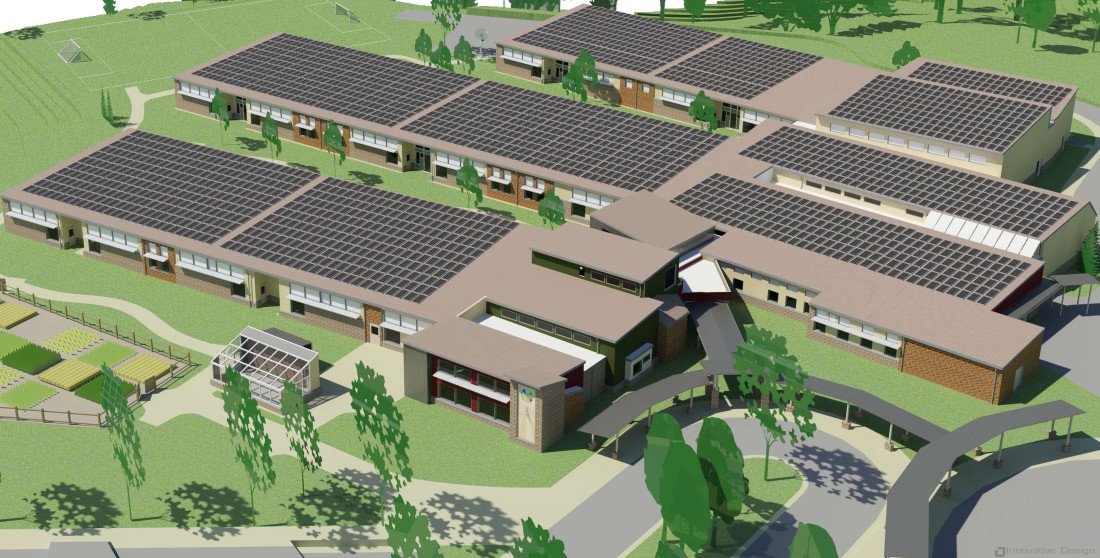Appalachian Offsets is providing an opportunity for Asheville residents to both protect the environment and invest in environmental education, by helping fund Isaac Dickson Elementary School’s much-anticipated 600-kilowatt solar system. Donations can be made via Appalachian Offsets’ website, which calculates a person’s carbon footprint and then asks for a donation to offset that footprint.
The solar power system will provide $4.5 million worth of renewable energy over 30 years and also serve as a learning laboratory for students.
Founded in 2007 by the nonprofit WNC Green Building Council, Appalachian Offsets recently launched the campaign, which aims to raise $220,000 from area individuals and businesses. Once that goal is reached, Sundance Power Systems will recruit large investors to cover about $800,000 in additional costs. Investors will receive tax credits and earnings from the sale of energy generated by the system.
Isaac Dickson was designed as one of the state’s first net-zero-energy schools and has been awaiting the installation of planned rooftop-based solar arrays since building construction was finished last year.
 “Through Appalachian Offsets, we are embarking upon the largest community-supported clean energy project yet in our area,” says Sam Ruark-Eastes, executive director of the WNC Green Building Council.
“Through Appalachian Offsets, we are embarking upon the largest community-supported clean energy project yet in our area,” says Sam Ruark-Eastes, executive director of the WNC Green Building Council.
“In August 2016, the Asheville school system opened a new LEED Platinum building to house Isaac Dickson Elementary School with advanced energy efficiency,” Ruark-Eastes continues. “The school was designed to take advantage of solar gain, and only needs a solar system to make this building a ‘net zero’ energy school.”
“Installing a rooftop solar system on the new Isaac Dickson Elementary will fulfill the architects’ vision of using the school building itself as learning tool that can be used to facilitate discussions about our environment and conservation, as well as the impacts of fossil fuel consumption, not just on our climate, but also on our air and water quality,” according to Isaac Dickson Elementary PTO Co-President Matt Menne in a press release.
“Incorporating solar into the school provides the chance to teach students about the nature of energy production and use,” Ruarke-Eastes says. “They can also learn about the history of solar energy, how photovoltaics work, and how the energy that is produced is used to power the lights, heating and cooling equipment, computers, and kitchens.”
Sundance Power Systems won the bid from Asheville City Schools to secure large capital investors and to install the $1.1 million solar system once Appalachian Offsets has raised $220,000 in donations. Appalachian Offsets hopes to raise the needed donations this year.
Once the donation goal has been met, Sundance is charged with securing investors. According to Dave Hollister, Sundance president & CEO, there are three main benefits for investors: a 30 percent tax credit; proceeds from the sale of electricity to Duke Energy Progress; and an accelerated six-year depreciation schedule. Sundance used a similar approach successfully on a project for Catawba College in 2015.
“If the community raises the $220,000, the school is essentially getting a million-dollar system for free that will deliver millions of dollars of benefits over its life,” Hollister said in a press release. “It’s a win for the community, the school, the environment and the investors.”
“By combining investors with community funds, [the project] reduces how much has to be raised from the community and allows the benefits of the solar system to accrue to the school much sooner,” Ruark-Eastes says.
Those wishing to donate can go directly to www.cutmycarbon.org, which calculates a business’ or individual’s annual carbon footprint and accepts tax-deductible donations to offset that footprint. For example, an average American family of three has a carbon footprint of 60 metric tons per year, according to Ruark-Estes. “If that family donates $20/ton to offset that footprint, the family would donate $1,200, of which 95 percent goes to the Isaac Dickson solar system,” he said.
“If we see how our much carbon emissions come from our energy use, transportation, food choices and waste, we can choose to offset those emissions and turn the course of our culture into a brighter future,” Ruark-Eastes says.
“We want to be an example to our kids of how we can make smart choices for a better future and how … our energy [choices have] a direct impact on our lives, community and the environment,” Ruark-Eastes says.

The solar system will include monitors that display operating levels and the amount of the clean energy produced and its relation to the metric tons of CO2 and the number of trees planted.
“Being educated in a green school will expose the kids with understanding how the places we learn, live and work impact our heath and sustainability,” he adds.
Ruark-Eastes recalls a dinner with his then 8-year-old niece as especially significant in light of the fundraising campaign for the solar system. During the meal, he asked her to name one of the major concerns she has about the world. She answered: “Climate change.”
“The fact that she was 8 and understood one of the major challenges we face from a global world view gives me hope,” Ruark-Eastes says. “The kids who live in our area are being educated and exposed to some really bright ideas. So many kids now understand about energy issues, food choices and watershed ecology, and are loving exploring creeks and mountains. It’s inspiring that the kids of today are connecting with their environment, and we hope that through projects like these solar energy systems that they will embrace and co-create a sustainable future.”
To learn more about Isaac Dickson Elementary School, visit the school’s website.




Before you comment
The comments section is here to provide a platform for civil dialogue on the issues we face together as a local community. Xpress is committed to offering this platform for all voices, but when the tone of the discussion gets nasty or strays off topic, we believe many people choose not to participate. Xpress editors are determined to moderate comments to ensure a constructive interchange is maintained. All comments judged not to be in keeping with the spirit of civil discourse will be removed and repeat violators will be banned. See here for our terms of service. Thank you for being part of this effort to promote respectful discussion.